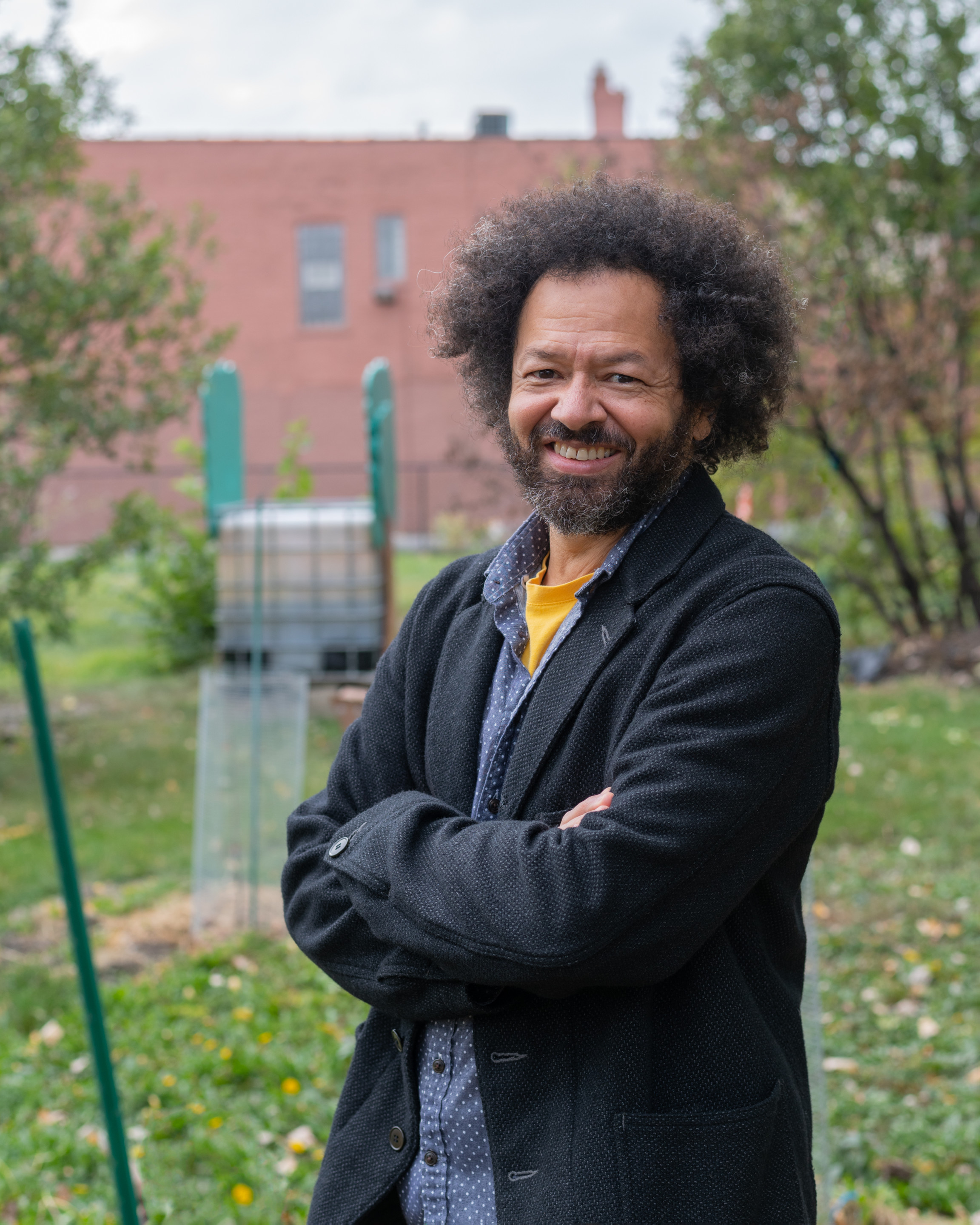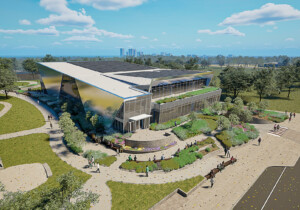A simple idea has preoccupied David Brown for over a decade—that of “collective space.” Brown, who works out of North Lawndale, Chicago, as a designer when he isn’t teaching at the University of Illinois at Chicago, derived the notion from the potential he saw in the thousands of empty lots strewn across the city. Because a good deal of the lots are municipally owned, he imagined that they might be developed by communities piecemeal or, more ambitiously, in coordination. If aggregated, these spaces would yield an acreage comparable to that of the Chicago Loop.
This fall, Brown was named the artistic director of the fourth Chicago Architecture Biennial. He is a beneficiary of the program, having participated, in one way or another, in the 2015 and 2019 editions. For the 2021 edition, Brown will further develop opportunities for collective space in Chicago and beyond through an umbrella concept he calls the Available City.

AN’s executive editor, Samuel Medina, spoke to Brown about his plans, how they have been shaped by this year’s events, and what architecture can—and can’t—do.
AN: It’s been a momentous year on all fronts. Has 2020 changed your conception of the city?
David Brown: In some ways, the current moment has made the Available City more relevant than at any other point in its development. The street closures and reduced [vehicular] traffic have been fascinating because all of a sudden you are able to move through the city much more fluidly.
But the project is and always has been concerned with a different set of variables, particularly existing land conditions. It’s principally embedded in 18 Black communities in Chicago on the South and West Sides. These neighborhoods and wards have not seen a lot of city resources or investment, yet they sit on one very big resource—public land. You have 13,000 vacant city-owned lots in these places that could form the basis of what I call “collective space.” What that means, really, is giving people and groups the ability to coordinate sets of spaces for themselves, where they feel reflected in their city. [These spaces] can be recreational or they can foster businesses and job opportunities. Either way, it’s about getting people to see this land as a publicly accessible resource, which is a part of racial justice.
How do you prevent this from becoming a series of ad hoc, disconnected spaces?
What the project pushes against is thinking about one single lot—or even several lots—in isolation. It’s one urban proposition. But there is an improvisational aspect to it as well. What I mean by that is in developing these vacant lots you’re offering opportunities for neighborhoods to experience new spaces that they wouldn’t have otherwise. And those experiences might help them identify other spaces, or programs, they would like to see [implemented] at other lots.
This is something you’ve seen happen already?
So in the North Lawndale neighborhood—which I know well, having done an exhibit there back in 2006 and building a number of relationships there over time—I’ve participated in workshops and meetings to help residents and organizations develop an idea they had for turning vacant city lots into community gardens. I worked with them to write a program brief, as well as reach out to foundations to help realize these spaces. Later we successfully applied for partner programming for the [2019 Chicago Architecture] Biennial. That’s what the Available City has developed into by this point.
The project has had a long incubation period. What brought you here to this moment?
I started around 2008 by mapping all the lots. That’s a lot easier now, but in 2008/9, all you could get was a paper document. After a few years I developed the first instance of the project for the Venice Architecture Biennale in 2012. That’s where I presented the idea of one urban proposition for all these thousands of vacant lots equal to the size of the Loop. At the time I was more focused on developing new building types for these public and private-adjacent lots [whose form] could accommodate spaces for the community or nonprofits. Then for the [Chicago] Biennial in 2015, I looked at the big scale and began treating these lots as surfaces. Doing that opened the door to all kinds of programmatic opportunities, which can be articulated through hard- and softscapes, as well as low-story buildings. Then there was the North Lawndale partner programming for the 2019 biennial. So in a big way the project has always been propelled by biennials.
How do you plan to expand or export the method to other, comparable cities, if that’s indeed the aim of the forthcoming biennial?
It’s not an atypical condition. You find these vacant lots all over Detroit. You find them in Houston, where you may have large parcels of vacant land as opposed to the gaps in city blocks. However, what is unique in Chicago is the fact that the city owns so much of [the vacant land]. The ability to [exploit that] isn’t reliant on technology, exactly, but much more so on policy. Defining these lots as new public space at the city level would be transformative.
I’d like you to expand on what you just said about definitions and policy frameworks. The naming of the project—the Available City—is certainly evocative, but “availability” can also be construed as something akin to “access.” I’m using scare quotes there because access gets bandied about in lieu of a concrete provision or entitlement.
We can think about access to the city, but somewhat to your point, we are still constraining ourselves to the primary core. Currently the Loop is operating at a highly reduced capacity, which forces us to ask, “Well, what if we took the size, investment, and potential of the Loop and distributed all that across other areas of the city? And what if communities in those areas were really getting the opportunity to shape [those resources] themselves?” Perhaps the idea of access to land becomes more appropriate then.
I noticed that in previous iterations of the project, great emphasis was placed on representation. Was this primarily for the benefit of designers, or did you imagine that they would be legible to people in the 18 communities circumscribed in your project? I ask because the shape grammars and tangrams you developed are quite complex…
I may be the only one who really understands those tangrams [laughs]. The representation [as a whole] was a tentative device that would evolve into something more “usable.” But some of that complexity was the result of my working with various collaborators over the years to develop a vocabulary for collective space that spans small spaces and soft- and hardscapes like parks and gardens to buildings. It’s through those conversations and interactions that we [were] able to come up with thousands of situations and [massing] studies. If it were up to myself, I probably couldn’t come up with more than 20 before they started to become redundant.
How do you intend to stage these conversations and workshops when many are unlikely to visit Chicago or the Cultural Center [the biennial’s primary venue] because of pandemic restrictions?
It’s something I’m only beginning to work out. It may very well be the case that there’s a large set of participants but everything is happening remotely. It will be interesting to put residents and organizations here in Chicago in rich conversations with designers from around the world. You could find commonalities of site conditions—for example, old industrial areas that could be reclaimed and reconverted for new uses. You could have conversations about public ownership and what that allows you to do in different contexts. You could talk about land use. But it’s also important that we foreground design and its role in these exchanges.
Both the pandemic and street movements of this year have provided opportunities for convergence—of political energies and ideas—and divergence. But let’s focus on the former. It seems extremely rare that design ever achieves anything approaching that convergence.
You’re right, you have to have a sense of what design can and can’t do. What it can do is reimagine how existing spaces or conditions can be used in new ways, especially in times like a pandemic. For example, the street closures I mentioned earlier have led to a reevaluation of how we utilize streets. Design wasn’t responsible for that, but design can definitely build on it. We could do the same for vacant land, especially if we think of it as one large site. The instances where you are able to realize collective spaces can be very generative. So it’s trying to capitalize on success and on energy, while also recognizing that these changes are not the exclusive territory of design [nor are they] the exclusive territory of individuals and organizations operating on their own. There can be a merger of the two.










